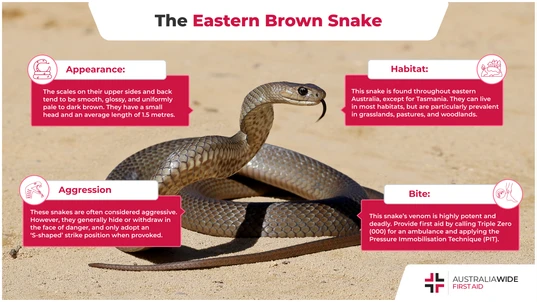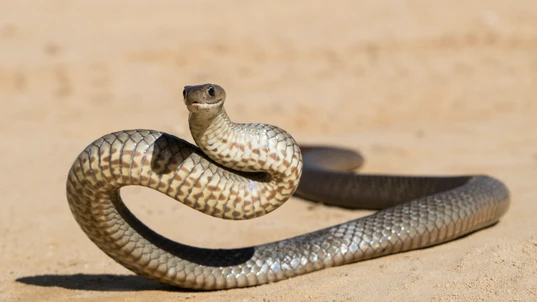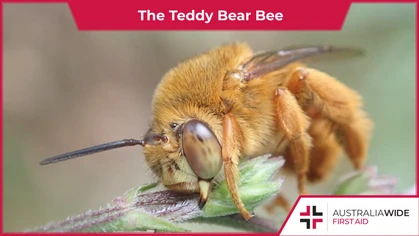Snake Facts: The Eastern Brown Snake

Bites and Stings

Eastern brown snakes are widely distributed across eastern Australia and are most commonly encountered in the spring. It is important to know first aid for a bite from an Eastern brown, as they are the second most venomous land snake in the world.
The Eastern brown snake is the second most venomous land snake in the world after the inland Taipan. This snake is renowned for adopting a defensive ‘S’ shaped strike position when provoked. Their predators include birds of prey and feral cats. And while they are immune to the venom of the Mulga snake, they are not immune to the venom of the cane toad. In fact, many Eastern brown snakes die after ingesting cane toads and their venom. In this article, we will cover all the important points that you need to know about the Eastern brown snake, including where they are from, whether we are safe from them, and what to do if one bites you. Let’s get into it!What are Eastern brown snakes?
Also known as the Common brown snake, the Eastern brown snake belongs to the Elapidae family of venomous snakes. The Elapidae family comprises approximately 360 different snake species and more than 170 different subspecies. Snakes from the Elapidae family are renowned for their permanently erect fangs and a unique threat display, wherein they lift the front part of their body off the ground, flatten their necks and open their mouths.What do Eastern brown snakes look like?
Eastern brown snakes are medium sized and have a small head. The scales on their upper sides and back tend to be smooth, glossy and a uniform pale to dark brown, though they can also come in black or burnt orange. Their eyes are characterised by an orange iris, a round pupil, and a thick black rim. On average, they are 1.5 metres in length, though the largest Eastern brown snake ever recorded was almost 7 feet long. They are commonly mistaken for many other snakes, including the Speckled brown snake, Mulga snake and the Taipan.What do Eastern brown snakes eat?
In the wild, Eastern brown snakes eat mice, rats, birds, frogs, other reptiles and the eggs of other reptiles. Smaller specimens eat lizards and small reptiles, while larger specimens prey on warm-blooded animals. Eastern brown snakes hunt during the day. However, on very hot days they tend to delay hunting until the evening. They have good eyesight. Once they find prey, Eastern brown snakes will chase and subdue it with venom and constriction. In captivity, they are known to be cannibalistic and to prey on snakes their own size.Where are Eastern brown snakes found?
Eastern brown snakes are found all over eastern Australia, from North Queensland to South Australia and western part of the Northern Territory. They are found over most of Queensland, New South Wales and Victoria. In south-eastern Queensland, the Eastern brown snake is commonly found around Ipswich and Beenleigh. They can adapt to almost every habitat except the rainforest, including dry eucalypt forests, savannahs, grasslands, scrublands and farmlands. Eastern brown snakes are most commonly encountered in the spring, though they are also active on mild winter days and can sometimes be seen basking in air temperatures as low as 14 degrees Celsius.Looking to get you First Aid knowledge up to date?
We run certified First Aid courses throughout all major Acustralian citys. Find a location near you.

The Eastern Brown snake’s infamous 'S' shaped strike position.
Are Eastern brown snakes aggressive towards humans?
Eastern brown snakes are solitary in nature – in fact, females and young males prefer not to cross paths with adult males. These snakes move very fast and can even outpace a person running at full speed. In a study that monitored 455 encounters between Eastern brown snakes and humans, it was found that the snakes advanced in only 12 encounters. For the remaining encounters, they either withdrew or tried to hide. The snakes’ defensive displays are often mistaken for acts of aggression.Are Eastern brown snakes dangerous to humans?
Although the average venom yield is 4mg, it is highly potent. Venom from an Eastern brown snake contains neurotoxins (toxins that are destructive to nerve cells), cardiotoxins (toxins that are destructive to cardiac muscle cells) and nephrotoxins (toxins that are destructive to kidney cells). If left untreated, a bite from an Eastern brown snake can cause progressive paralysis and excessive bleeding. Many deaths occur due to excessive bleeding in the brain from consumptive coagulopathy, a condition affecting the blood’s ability to clot. Eastern brown snakes are responsible for an estimated 60% of human snake bite deaths in Australia. It is worthwhile noting, most bites occur when a person attempts to kill the snake, so it’s always best to leave them alone and wait for a professional snake catcher.First aid for an Eastern brown snake bite
- Keep the casualty at rest and as still as possible to stop the venom from travelling through the body.
- Constantly observe and reassure the casualty.
- Follow DRSABCD and be prepared to perform CPR
- Apply the ‘pressure immobilisation technique’ (PIT):
If the bite site is on a limb, cover it with a wide heavy elastic bandage (10 - 15 cm wide).
Ensure the bandage is firm and tight, so tight you cannot easily slide a finger between the bandage and the skin.
Apply a second heavy elastic bandage. Start from the fingers or toes and wind up the limb as far as possible. Consistent coverage (overlapping half over half) and consistent pressure (firm but not cutting off circulation) are key to an effective PIT. - Immobilise the limb and joints with a splint, or use a sling if the bite site is on an arm. Keep the limb immobilised until the ambulance arrives.
Snake bites and anaphylaxis
Some people can have a severe allergic reaction when bitten by a snake. This is called anaphylaxis, a condition that can be fatal in as little as 15 minutes. Symptoms include:- Tightness of the throat from swelling.
- Difficulty breathing.
- Tongue and facial swelling.
- Hoarse voice or difficulty speaking.
- A wheeze or persistent cough.
- Collapse or falling unconscious.
- Becoming pale or floppy (young children).
- Abdominal pain and vomiting.
- Hives, welts, and body redness.

One way to avoid snake bites is to check for snakes before picking up rocks, sticks or wood. When walking through scrubland, you should also make a lot of noise to alert snakes of your impending arrival.
Ways to avoid snake bites
- Wear boots and long pants while walking through prime snake territory, such as dry forests and scrublands, and stay on designated trails.
- Do not touch or disturb any snakes you come across, either at home or in the wild.
- Always check for hiding snakes before picking up rocks, sticks or wood.
- While walking through dry forests, scrublands and other prime snake territory, always take a buddy.
- While walking through prime snake territory, let the snakes know you are there by making noises and stomping your feet - though snakes cannot hear well, they can sense vibrations in the ground.
Final thoughts
To learn how to provide first aid for an Eastern brown snake bite, such as applying a pressure immobilisation bandage and splint, book a First Aid course with Australia Wide First Aid today! More information about Eastern brown snakes can also be found in our article on common snakes in the greater Brisbane area.
Originally published at
https://www.australiawidefirstaid.com.au/resources/eastern-brown-snake
as part of the Australia Wide First Aid Articles Library









